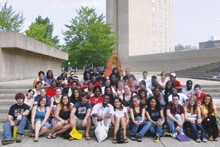Many US students may not be able to take up their university places this year, as banks clamp down on credit in the midst of the economic downturn. More than 80 US lenders, collectively responsible for 14 percent of all private student loans, have stopped such provision. Others have placed tighter restrictions on borrowing. The decline in house prices also means parents have less property equity to borrow against, leaving students anxious about paying their tuition bills for the 2008-09 academic year.
 The credit crunch forced Congress to intervene in May to assure students and their families that loans will remain available through an emergency government programme, with the federal government acting as the lender of last resort. But despite the last-minute bailout, some students are still expected to be denied credit, while for those who get loans, borrowing fees and interest payments are expected to be much higher in 2008-09. There is growing concern that many students especially those from lower socio-economic groups, will fail to take up their places in autumn, while others may switch to cheaper, shorter courses at community colleges.
The credit crunch forced Congress to intervene in May to assure students and their families that loans will remain available through an emergency government programme, with the federal government acting as the lender of last resort. But despite the last-minute bailout, some students are still expected to be denied credit, while for those who get loans, borrowing fees and interest payments are expected to be much higher in 2008-09. There is growing concern that many students especially those from lower socio-economic groups, will fail to take up their places in autumn, while others may switch to cheaper, shorter courses at community colleges.
Low consumer confidence has led to renewed questions about the high price of private higher education in the US, with the combined costs of tuition and other fees at leading private universities approaching the median US household income of $48,200 (Rs.20.24 lakh) per year. “It won’t necessarily be evident how bad it is until all the students have gone into the market to find loans… and the bills start being sent out in July,” says James H. Day of Hardwick Day, a consulting firm to private universities that specialises in financial aid and other issues.
Adds Peter Mazareas, vice chairman of the College Savings Foundation: “The most significant impact will be on middle-class and still-dependent students, simply because they need to borrow generally more than the federal loan programme provides. If they are able to find private loans, the qualifications have also increased, and the interest will also increase. It ultimately becomes an issue of class polarisation.” The US education department estimates that about 7 million borrowers will need more than $68 billion (Rs.285,600 crore) in federal loans for the next academic year.
The credit crunch has exposed the fact that student loans are estimated to account for 40 percent of private university revenue, says Day. “I don’t think higher education understands the extent to which it is dependent on loan capital. Colleges have not internalised the fact that they have to establish a different kind of relationship with families in terms of financing affordability. Colleges are still in the mode of presenting the tuition bill and saying: ‘Good luck’.”
But with universities enjoying the highest number of applications since the baby boom, there is little incentive for them to make changes.
Research fraud alarm
Research fraud among scientists in the us might be more common than previously thought and the rate at which it is reported “alarmingly” low, a new study suggests. A report polled more than 2,200 federally financed scientists on instances of research misconduct such as fabricating data and plagiarism that they themselves had witnessed. The results, published in the journal Nature, give a conservative estimate of 2,325 possible cases of research fraud each year.
The survey, which is said to be the largest and most systematic to date, found that only 1,350 of these incidents — 58 percent of all the cases — were reported to university officials. The report’s authors included an official from the US government-financed Office of Research Integrity (ORI) which sponsored the study. In a peer-reviewed commentary, the authors called the reporting rate “alarming” and said that it “calls into question the effectiveness of self-regulation”.
In the US, institutions that get federal grants must investigate allegations of research misconduct themselves. Few cases are referred to ORI. Previous studies have suggested that up to four in ten whistle-blowers are pressured by their institution to drop allegations. Institutions were often keen to avoid the expense and embarrassment of a full-scale investigation, say the authors of the study. The report expresses worry about the “failure to foster a culture of integrity” within the research community.
“Nearly one generation after the effort to reduce misconduct in science began, the responses by scientists suggest that falsified and fabricated research records, publications, dissertations and grant applications are much more prevalent than has been suspected to date…We hope it will lead individuals and institutions to evaluate their commitment to research integrity,” say the authors of the study.
The US is generally thought to have a more entrenched “whistle-blower culture” than elsewhere, which makes the findings on low reporting all the more surprising.
(Excerpted and adapted from The Economist & Times Higher Education Supplement)